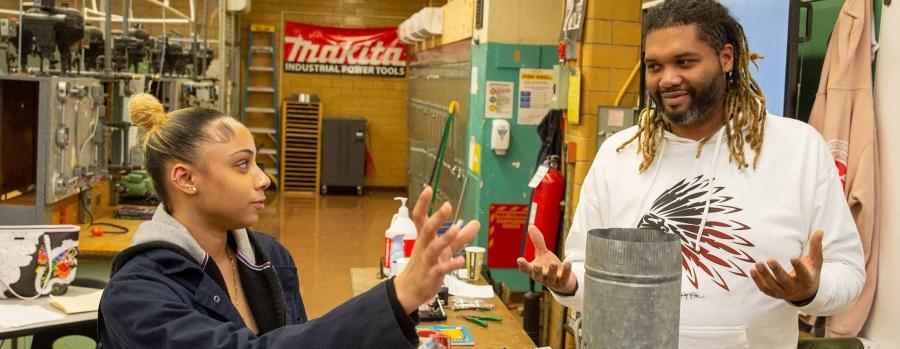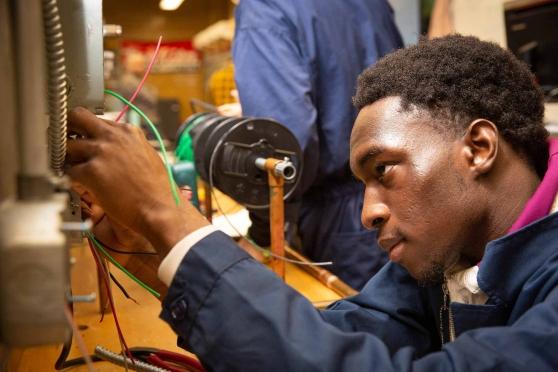
Teacher Orvil Boatswain, who runs the HVAC program at Bronx Design and Construction Academy, explains to student Stephany Mejia the workings of a device that simulates heat operating in a furnace.

Mamadou Kante works on a circuit breaker in the school’s lab. Boatswain says by October, students know enough about their work that “the shop is theirs.”
“The average student that comes to us as a 9th-grader, what they know about is carpentry and electric,” says Orvil Boatswain, the dynamo behind Bronx Design and Construction Academy’s award-winning heating, ventilation and air-conditioning program. “They know nothing about HVAC.”
Students ask what it is, and Boatswain answers their question with his own. “You ever wake up with no hot water?” Typically, they’ll say they call their building’s super. “And I’ll tell them, the supers do nothing — they just call us,” he says.
While many students are unfamiliar with technicians who are responsible for the systems that regulate and move heated and cooled air, the need for the service is universal. And word is getting out about Boatswain’s work at the Concourse school, where he prepares students to do that job in residential and commercial buildings, working for businesses ranging from local heating companies to construction firms to the Metropolitan Transportation Authority.
Boatswain’s program is the only one in New York City public high schools that teaches all aspects of HVAC, and it regularly wins an annual statewide competition judged by private-industry professionals.
Jeffrey Kaufman, a graduate of the perennial state runner-up, Saunders Trade and Technical HS in Yonkers, is now Boatswain’s colleague; he came to Bronx Design in September and also teaches HVAC. Standing in Boatswain’s 3rd-floor lab recently, Kaufman said, “I come up here every day just to learn from him.”
Chapter Leader Tamara Wallace says the school has come a long way from its early years, when “the students we got were assigned here. Now we’re getting more students who actually want to be here.”
Boatswain’s program teaches its 20-plus students the technical aspects of HVAC while treating their studies like an actual job. At the end of each project, students are required to produce an invoice covering labor costs, materials and city taxes. Each day that they arrive on time, they “earn” a photocopied dollar bill that can be redeemed at the school store.
Girls choosing Bronx Design now make up 30% of the student population. which was virtually all male when the school opened in 2011. Stephany Mejia, an 11th-grader, said no one she knew had a background in HVAC. When she came into the program, it took time for “my brain to process all this,” she said, but she quickly became comfortable because Boatswain is “a good explainer.”
He draws students out by soliciting their suggestions. He asks them, for example, where to install a thermostat. When they offer a possible location, he asks: “Let’s explore that — is that a good idea?”
When one student asks, “Was there AC when you were a kid?” Boatswain, 41, laughs. “You think I’m that old? Yes, there was AC; what you want to ask is, did I have it?”
He uses the same friendly banter to communicate the importance of paying attention to detail. He tells a student who’s inquisitive but not always careful, “It’s a teenage thing; I get it. But it’s the little things that come back to get you.”
In the lab, students probe electrical outlets for possible problems, following diagrams for whichever system they are examining. “Your meter is just like a doctor’s stethoscope,” Boatswain tells one student who’s checking the voltage and switches in a line.
They learn how to use electrical boxes and decipher color-coded wires and are graded on project operations, procedure, appearance, the time it takes to complete the work, their knowledge of the electrical code and their ability to read diagrams.
“It’s layered for them to struggle but not get stuck,” Boatswain said of the tasks students must perform.
Freshmen study each trade taught at the school before deciding on a specialty. At the end of sophomore year, they can begin apprenticeships with local companies that Wallace hopes “will lead to a union job.”
Boatswain passed the written and practical exams covering every trade given by the National Occupational Competency Testing Institute, the leading provider of industry credentials and resources for CTE programs nationwide. He has “been key to our work-based learning,” Wallace said, serving as the school’s liaison to companies that provide internships and career opportunities. “He’s truly been a blessing to our school.”
As an algebra teacher, Wallace appreciates that Boatswain helps students understand the importance of math in many trades.
He is also a role model. Boatswain came to New York from Antigua at 13 and worked three jobs to support himself. After high school, he entered the Success Via Apprenticeship Program and did HVAC work for a private company while attending New York City Tech in Brooklyn. A teacher since 2007, Boatswain started at Bronx Design in 2014.
“If I can do it,” he tells his students, “you can do it.”